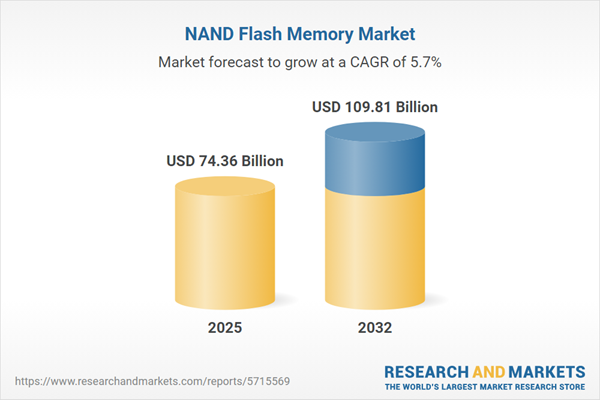Speak directly to the analyst to clarify any post sales queries you may have.
The NAND flash memory market is experiencing rapid evolution as sector leaders respond to new storage requirements, heightened performance standards, and complex global supply dynamics. Senior decision-makers are advancing strategies to remain agile and competitive amid changing technological and regulatory landscapes.
Market Snapshot: NAND Flash Memory Market Size and Growth
The NAND flash memory market grew from USD 70.32 billion in 2024 to USD 74.36 billion in 2025 and is projected to reach USD 109.81 billion by 2032, reflecting a compound annual growth rate (CAGR) of 5.72%
. Expansion continues to be driven by enhancements in memory layer density, more advanced interface protocols, and increased adoption across automotive, enterprise IT, and emerging sectors. The enduring relevance of NAND technologies ensures that organizations benefit from robust, flexible storage solutions that can be tailored for various workloads and operational scales.NAND Flash Memory Market Scope & Segmentation
- Memory Types: Multi-level cell (MLC), single-level cell (SLC), triple-level cell (TLC), and quad-level cell (QLC) enhance operational alignment with endurance and capacity needs.
- Architectures: 2D planar and 3D vertical stacking technologies enable optimized storage density and reliability, adaptable from edge applications to large-scale centralized computing.
- Interfaces: Diverse support for PCIe Gen 3/4/5, NVMe, SATA, and USB facilitates performance optimization, meeting requirements from fast data centers to entry-level deployments.
- Form Factors: eMMC, internal and external SSD, microSD, UFS, and USB drive configurations allow for embedded, modular, and portable applications across commercial and industrial settings.
- Applications: Utilized extensively in automotive electronics, consumer devices, smartphones, and enterprise platforms for high-speed access, data integrity, and scalable storage.
- End Users: Automotive, IT and telecom, industrial, and consumer electronics sectors utilize these technologies for both edge processing and traditional core systems.
- Capacity Tiers: Solutions range from under 128 GB to beyond 1 TB, supporting everything from lightweight devices to intensive enterprise storage needs.
- Distribution Channels: Comprised of direct sales, OEM partners, authorized distributors, and online retail to suit evolving procurement strategies and enterprise buying habits.
- Geographies: Operations span the Americas, EMEA, and Asia-Pacific regions, with market influence led by the United States, China, Germany, Japan, and South Korea.
- Key Companies: Key market drivers include Samsung Electronics, Kioxia Holdings, Western Digital, SK hynix, Micron Technology, Intel, and Yangtze Memory Technologies, each shaping technology progression and industry direction.
Key Takeaways: Strategic Insights for Decision Makers
- Increasing adoption of advanced cell architectures and 3D vertical stacking supports digital infrastructure demands and improves energy efficiency for enterprise and industrial environments.
- Expansion of PCIe-based NVMe interfaces allows for greater system compatibility and reduced latency, which proves essential for organizations striving to improve real-time storage performance.
- Innovation in controller technology and versatile form factors drives custom-built memory solutions for applications such as smart automotive safety systems and edge computing in industrial IoT environments.
- Collaborative relationships with OEMs and ecosystem partners foster development of resilient memory platforms, ensuring compliance with rigorous operational and regulatory expectations.
- Organizations that prioritize agile supply chain structures and sustainable manufacturing practices are better positioned to handle uncertainty and regulatory adjustments.
Tariff Impact: Navigating Regulatory Change in 2025
Recently introduced U.S. tariffs targeting semiconductor imports are affecting procurement and supplier management across the NAND flash memory sector. To maintain business continuity, manufacturers are shifting toward regionalized production and diverse sourcing strategies while OEMs and enterprises adapt supply chains to reduce exposure to regulatory risks. Companies investing in adaptable procurement and cultivating robust supplier networks are showing greater resilience in the face of ongoing policy shifts.
Methodology & Data Sources
This report incorporates executive-level interviews, analysis of proprietary shipment data, sector-specific literature review, and an examination of current patent trends. Quantitative modeling and structured expert validation provide insights designed specifically for the needs of technology industry leaders.
NAND Flash Memory Market: Why This Report Matters
- Equips senior leaders with tailored planning tools to address shifting deployment goals and evolving global trends in the NAND flash memory market.
- Facilitates agile procurement and sourcing decisions amid disruptions and changes brought by new regulations or supply chain adjustments.
- Delivers actionable segmentation and in-depth geographic insights to support investments in technology acquisition, R&D, and international expansion initiatives.
Conclusion
Ongoing technology advancement and changing regulatory frameworks are shaping the future of the NAND flash memory sector. Reliable market intelligence enables organizations to strengthen strategies and take advantage of emerging global opportunities.
Additional Product Information:
- Purchase of this report includes 1 year online access with quarterly updates.
- This report can be updated on request. Please contact our Customer Experience team using the Ask a Question widget on our website.
Table of Contents
3. Executive Summary
4. Market Overview
7. Cumulative Impact of Artificial Intelligence 2025
List of Figures
Samples

LOADING...
Companies Mentioned
The key companies profiled in this NAND Flash Memory market report include:- Samsung Electronics Co., Ltd
- Kioxia Holdings Corporation
- Western Digital Corporation
- SK hynix Inc.
- Micron Technology, Inc.
- Intel Corporation
- Yangtze Memory Technologies Co., Ltd
Table Information
| Report Attribute | Details |
|---|---|
| No. of Pages | 186 |
| Published | October 2025 |
| Forecast Period | 2025 - 2032 |
| Estimated Market Value ( USD | $ 74.36 Billion |
| Forecasted Market Value ( USD | $ 109.81 Billion |
| Compound Annual Growth Rate | 5.7% |
| Regions Covered | Global |
| No. of Companies Mentioned | 8 |









